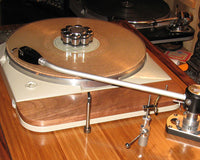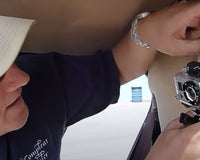Hey everyone, Ian here! Welcome to the workshop. We're heading into the holidays, which means it's either time to find the perfect gift for the tech-lover in your life, or it's time to start a new DIY project for yourself. Today, we're going to do both at the same time.
We're diving into the massive, wonderful, and obsessive world of custom keyboards.
If you or someone you know is a gamer, a programmer, or just spends all day typing, you've probably heard the terms. "Thock." "Clack." "Ping." The keyboard community is obsessed with acoustics, spending hundreds of dollars on switches, cases, and keycaps to chase that perfect, deep, satisfying sound.
But what if I told you the most dramatic sound upgrade for your keyboard doesn't cost $300? What if it costs less than $30 and takes you about 30 minutes?
Today, I'm going to show you the ultimate keyboard mod—the "secret weapon" that pros use to kill unwanted noise and unlock that elusive "thock." We're not just muffling sound; we're eliminating vibration at its source. We're going to use Sorbothane®.
The Problem: Your Keyboard Is Loud, But It's Not Its Fault
Your keyboard isn't just one solid object. It's an assembly of parts: switches, a metal or plastic plate, a circuit board (PCB), and a case. When you press a key, you're creating a tiny, high-frequency vibration. This "ping" (from the switch spring) and "clack" (from the keycap bottoming out) travels through the entire assembly.
Most keyboard cases, especially hollow plastic or aluminum ones, act like an echo chamber, making that "ping" even worse. This resonance is what we perceive as a cheap, hollow sound.
The Common "Fixes" (And Why We Can Do Better)
This is the most popular DIY fix. You open your keyboard and stuff the hollow space with packing foam, PE foam, or neoprene. This is a good first step! It helps muffle the airborne sound, cutting down on the "ping."
But foam is a porous muffler, not a dense absorber. It doesn't stop the structural vibration from traveling through the solid parts of the case. To truly kill the noise, you have to absorb that vibrational energy.
The Sorbothane® Solution: From "Clack" to "Thock"
This is where we, as engineers and makers, pull out the secret weapon. Sorbothane® is not a foam or a rubber. It’s a viscoelastic polymer.
This means it behaves like both a liquid and a solid. When a vibration (like a key press) enters it, Sorbothane® deforms and absorbs that energy, converting it into a tiny, negligible amount of heat.
While porous foam muffles airborne sound, dense Sorbothane® absorbs the structural vibration from the PCB and plate before it can even become airborne sound. It's a completely different level of damping. It also adds significant mass to the case, which is a key ingredient for that premium, low-pitched sound profile.
The Build: Two Ways to a "Thockier" Keyboard
There are two great ways to apply this. The 60-second mod is all about decoupling, while the 30-minute mod is about total case damping.
Project 1: The 60-Second Mod (The Easy "Decoupler")
This is the simplest, most effective upgrade if you don't want to open your keyboard.
-
Get: A set of our Sorbothane® Hemispheres (like the 3/4" or 1" hemispheres).
-
Do: Flip your keyboard over. Stick four of them (one in each corner) right on top of or next to the existing rubber feet.
-
Done. You've "floated" your keyboard. The Sorbothane® feet are now the only contact points, and they will absorb all the vibration before it can get to your desk, which is a major source of amplified noise.
Project 2: The 30-Minute "Case Damp" Mod (The Pro Way)
This is the ultimate solution. For this build, I'm using an inexpensive Hcman E-Sports K08R mechanical keyboard. These are perfect candidates because their hollow plastic cases benefit massively from this upgrade.
Materials & Tools:
-
Screwdriver (Phillips and/or Torx, depending on your board).
-
A parts tray (crucial for tiny screws!)
-
(Optional) Keycap puller.
-
Sharp scissors and an Xacto knife.
-
Ruler.
-
(Optional) Mechanical hole punch.
-
(Optional) Painter's tape.
Instructions:
-
Get Prepared: Set up your workspace. A parts tray is a lifesaver for all the tiny screws you're about to find.
-
Disassemble: Carefully disassemble your keyboard. On my Hcman, this meant removing all the keycaps to access the screws (there were more than I expected!). Be a detective: some screws may be hidden under rubber feet or stickers.

-
Separate and Disconnect: Gently lift the main PCB and plate assembly out of the bottom case tray. There will be a cord connecting the PCB to the USB port. Carefully disconnect this so you can fully separate the two halves.

-
(Optional Pro-Step) The Tape Mod: Here's a popular trick from the community (hat-tip to Hipyo Tech on YouTube). Apply a single layer of painter's tape to the back of the PCB. This slightly alters the sound profile and, more importantly, protects the Sorbothane® from the sharp solder points. Press it down firmly, but watch out for those contacts.

-
Measure and Cut Sorbothane®: Measure the internal flat area of your keyboard's bottom tray. Transfer this measurement to your Sorbothane® sheet.

-
Pro-Tip for Cutting: To get a clean, easy cut, you have two great options: (A) Leave the protective plastic film on while you cut with sharp scissors, or (B) Stick the sheet in the freezer for about an hour. Freezing makes it temporarily rigid, allowing for a super clean cut with scissors or an Xacto knife.

-
Handle the Mounts: Your case will have screw posts and plastic fins. Lay your cut Sorbothane® sheet inside and mark where the holes need to be. I found an old-school mechanical hole punch is perfect for the screw holes, and an Xacto knife works for any other odd-shaped cutouts.


-
Install and Reassemble: Peel the protective film off both sides of the Sorbothane® and press it into the bottom tray. It should sit flat. Carefully route the USB cord, reconnect it to the PCB, and reassemble your keyboard, making sure not to pinch any wires. Screw everything back together.

The Payoff: A Keyboard That Feels and Sounds Premium
The result is instant and not subtle at all. The keyboard is noticeably "thonkier."
It also has a significant, satisfying added weight. That hollow, high-pitched plastic "clack" is gone, replaced by a deep, solid sound. It genuinely feels and sounds like a keyboard that costs three times as much. For 30 minutes of work, this is the highest-impact mod in the keyboard world.
Why 70 Durometer Sorbothane®? For this internal mod, we used a 70 durometer sheet. Why? While softer Sorbothane (like 30) is the king of decoupling (like for feet), a harder, denser 70 duro is an incredible mass-loader. It's heavy and perfect for adding bulk to a hollow case and absorbing that resonant energy. It's the perfect "case-fill" material.
Happy building!
What keyboard are you planning to mod? Let me know in the comments!










